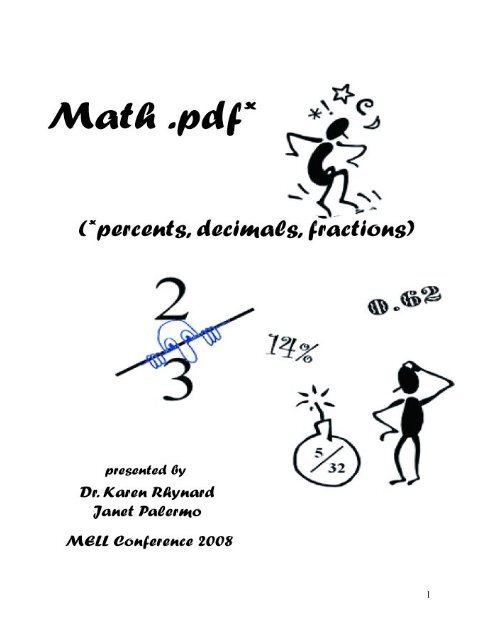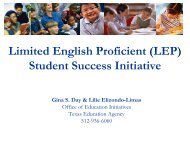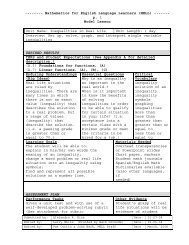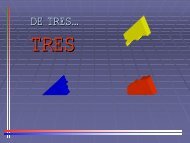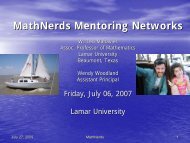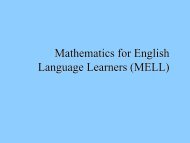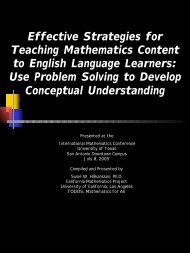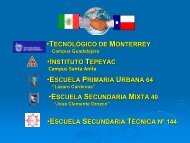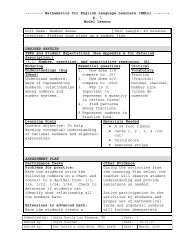MATH: PDF (Percent, Decimal, Fraction) - Mathematics for English ...
MATH: PDF (Percent, Decimal, Fraction) - Mathematics for English ...
MATH: PDF (Percent, Decimal, Fraction) - Mathematics for English ...
You also want an ePaper? Increase the reach of your titles
YUMPU automatically turns print PDFs into web optimized ePapers that Google loves.
Understanding <strong>Fraction</strong>al Relationships<br />
Complete the following problems.<br />
1. Draw a figure that represents 3 4 .<br />
2. Draw a figure that represents 0.5.<br />
3. Draw a figure that represents 150%.<br />
4. Label each figure as a percent, fraction, and decimal. These are ways to<br />
describe the same amount.<br />
2
1. Fill in the table below. Let the orange rod represent 100%.<br />
Rod Color <strong>Percent</strong> <strong>Fraction</strong> <strong>Decimal</strong><br />
2.<br />
Orange 100%<br />
Red<br />
Shade 30% of the bar. Label the fraction and decimal equivalents.<br />
3
3. Shade 70% of the bar. Label the fraction and decimal equivalents.<br />
4. Shade 150% of the bar. Label the fraction and decimal equivalents.<br />
5. Label the bar below with 40%, 0.6, and 3 4 .<br />
6. Put these numbers in order from least to greatest.<br />
40%, 0.6, and 3 4 ____________________________<br />
Let the brown rod represent 100%. Complete the table below <strong>for</strong> the other rod colors.<br />
Rod Color <strong>Percent</strong> <strong>Fraction</strong> <strong>Decimal</strong><br />
Brown 100%<br />
Purple<br />
Red<br />
White<br />
Orange<br />
Blue<br />
4
Estimating with <strong>Percent</strong> Bars<br />
1. Phoebe shot 12 times during the basketball game. She made 9 shots. What percent of<br />
her shots did she make?<br />
0 shots<br />
0% 50% 100%<br />
2. Caleb received a 30% discount on a DVD collection. If the regular price of the DVD<br />
collection was $80.00, how much did Caleb pay <strong>for</strong> the DVD collection?<br />
0$<br />
0% 50% 100%<br />
3. Jack bought tennis shoes that cost $108. The shoe store sells the shoes at 120% of<br />
their cost. What did the shoes cost be<strong>for</strong>e the markup?<br />
0$<br />
0% 50% 100%<br />
6
Bar Model<br />
7
Bar Model<br />
8
You need: Cuisenaire Rods<br />
• Brown rod = 1. What is 1 4 ?<br />
• Orange = 1. What is 1 2 ? What is 1 1<br />
? What is<br />
5 10 ?<br />
• Dark green = 1. What is 1 3 ?<br />
• Dark green = 3 4 . What is 1 ? What is 1?<br />
4<br />
• Brown = 2 3 . What is1 ? What is 1?<br />
3<br />
• Green = 3 5 . What is1 ? What is 1?<br />
5<br />
• Blue = 3 4 . What is 1 ? What is 1?<br />
4<br />
You need: Cuisenaire Rods<br />
Orange + Red = 1<br />
Find as many values as you can <strong>for</strong>:<br />
• The orange rod<br />
• The brown rod<br />
• The purple rod<br />
• The light green rod<br />
• The red rod<br />
9
Use a model to solve the problems below.<br />
Charlie ate 25% of a cake.<br />
John ate 3 of a cake.<br />
10<br />
Wendy ate 0.2 of a cake.<br />
Elaine ate the rest.<br />
Who ate the most? How do you know?<br />
Lyn made a quilt <strong>for</strong> Mrs. Malone’s new baby.<br />
1<br />
4<br />
1<br />
3<br />
2<br />
5<br />
of the quilt was yellow<br />
of what was left was green<br />
was pink<br />
10
The rest was blue. What part of the quilt was blue? How<br />
do you know?<br />
Using Manipulatives<br />
(Echevarria, Vogt, and Short, 2000)<br />
According to Echevarria, Vogt, and Short (2000), <strong>English</strong> language learners need<br />
opportunities to practice new knowledge and skills in highly contextualized ways which<br />
include the use of manipulatives. <strong>English</strong> language learners, like regular grade-level<br />
students, benefit from experimenting, constructing models, and manipulating objects.<br />
The key difference is that <strong>for</strong> <strong>English</strong> language learners, using manipulatives is a nonnegotiable.<br />
<strong>English</strong> language learners need to experience knowledge and skills in a<br />
tangible way especially when at the lower stages of <strong>English</strong> language development.<br />
What Makes This Strategy Good <strong>for</strong> ESL Students?<br />
• Provides activities that are context-embedded<br />
• Enables students to work at higher levels of cognition, more cognitively demanding<br />
• Provides concrete evidence of learning and understanding<br />
• Scaffolds students into the abstract<br />
• Can be used <strong>for</strong> assessment<br />
• Lowers the affective filter<br />
• Provides opportunities <strong>for</strong> vocabulary development<br />
• Cooperative activities provide opportunities <strong>for</strong> much needed interaction<br />
11
Differentiation<br />
What is Differentiation?<br />
“Differentiation is simply a teacher attending to the learning needs of a particular student<br />
or small group of students, rather than teaching a class as though all individuals in it were<br />
basically alike.”<br />
Carol Ann Tomlinson - 2000 University of Virginia<br />
“Differentiation is changing the pace, level or kind of instruction in response to learners’<br />
needs, styles, and/or interests.”<br />
Dianne Heacox 2002<br />
Differentiation is …<br />
o Proactive<br />
o More qualitative than quantitative<br />
o Multiple approaches to content/process/product<br />
o Blend of grouping techniques<br />
_________________________________________________________<br />
Types of Differentiation<br />
• Content (what is taught)<br />
• Process (how it is taught)<br />
• Product (shows what students have learned)<br />
Content Differentiation:<br />
offer similar materials at various levels of difficulty<br />
Process Differentiation:<br />
vary instructional techniques<br />
vary materials<br />
Product Differentiation:<br />
products student created to show learning<br />
differentiated products according to students’ characteristics --<br />
readiness, learning styles and interests (Dianne Heacox 2002)<br />
12
Linear Model of <strong>Percent</strong>s<br />
Cuisenaire rods (concrete) →pictorial bar model →numbers (abstract)<br />
Begin the lesson by assessing student’s knowledge of benchmark percents and<br />
fractions through questioning.<br />
Let the orange rod represent 100%<br />
o If the orange rod is 100%, which rod would represent 50%? How do you<br />
know?<br />
o What fraction is the yellow rod? What decimal?<br />
o Find the percents of all the other rods<br />
Relate percents, decimals and fractions<br />
Compare percents, decimals, and fractions<br />
Connect Cuisenaire rods to the number line<br />
Decompose percents<br />
Use another rod color to represent 100%, then find the percent of the other rod<br />
colors<br />
Represent percents on the pictorial bar model – use rods and centimeter ruler to<br />
determine percents<br />
Use a numerical value to represent 100% of the bar<br />
Use percent bars to model percent problems<br />
13
Part-to-Whole Relationships<br />
<strong>Decimal</strong>s and fractions are two different symbol systems <strong>for</strong> the same part-to-whole relationships.<br />
Rather than approach percents as a new idea, children should see that percents are simply a<br />
different way to record ideas about fractions and decimals. Rather than a third numeration system,<br />
percents are essentially a third symbolism <strong>for</strong> operators.<br />
The term percents are just another name <strong>for</strong> hundredths.<br />
Use realistic percent problems and nice numbers.<br />
• Limit the percents to familiar fraction (halves, thirds, fourths, fifths, and eighths) or<br />
easy percents ( 1 10<br />
, 1 ) and use numbers compatible with these fractions. The focus of<br />
100<br />
these exercises is the relationships involved not complex computational skills.<br />
• Do not suggest any rules or procedures <strong>for</strong> different types of problems. Do not<br />
categorize or label problems types.<br />
• Use the terms part, whole, and percent (or fraction). <strong>Fraction</strong> and <strong>Percent</strong> are<br />
interchangeable. Help students see these percent exercises as the same types of<br />
exercises they did with simple fractions.<br />
• Require students to use models or drawings to explain their solutions. It is better to<br />
assign three problems requiring a drawing and an explanation than to give 15 problems<br />
requiring only computation and answers. Remember that the purpose is the<br />
exploration of relationships, not computational skill.<br />
• Encourage mental computation.<br />
The dark green rod is one whole (100%). What strip is two-thirds (66 3 2 %)?<br />
What strip is three-halves (150%)?<br />
If this rectangle is three-fourths (75%), draw a shape that could be the whole (100%).<br />
What fraction (percent) of the set is red?<br />
○○ ○ ○○<br />
○ ○○ ○<br />
Elementary and Middle School <strong>Mathematics</strong>: Teaching Developmentally (Fourth Edition). Van de<br />
Walle, John A.<br />
14


